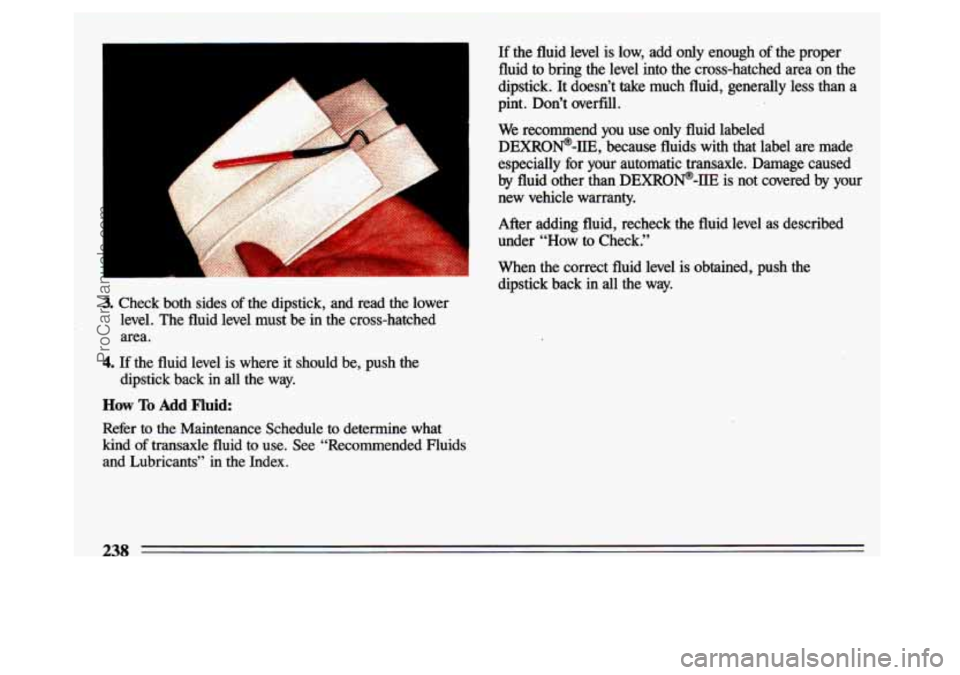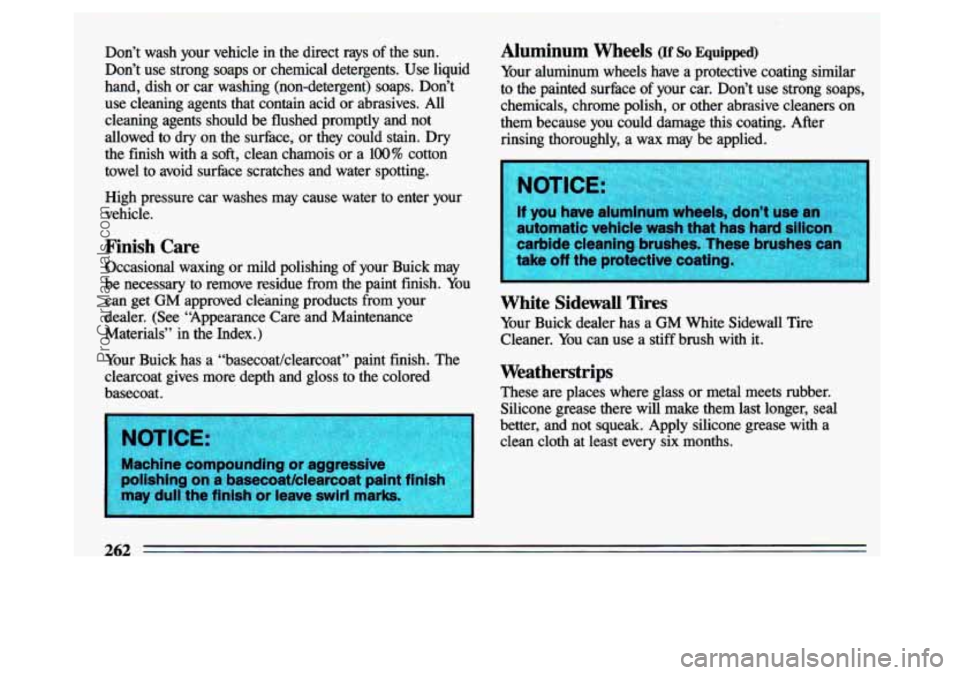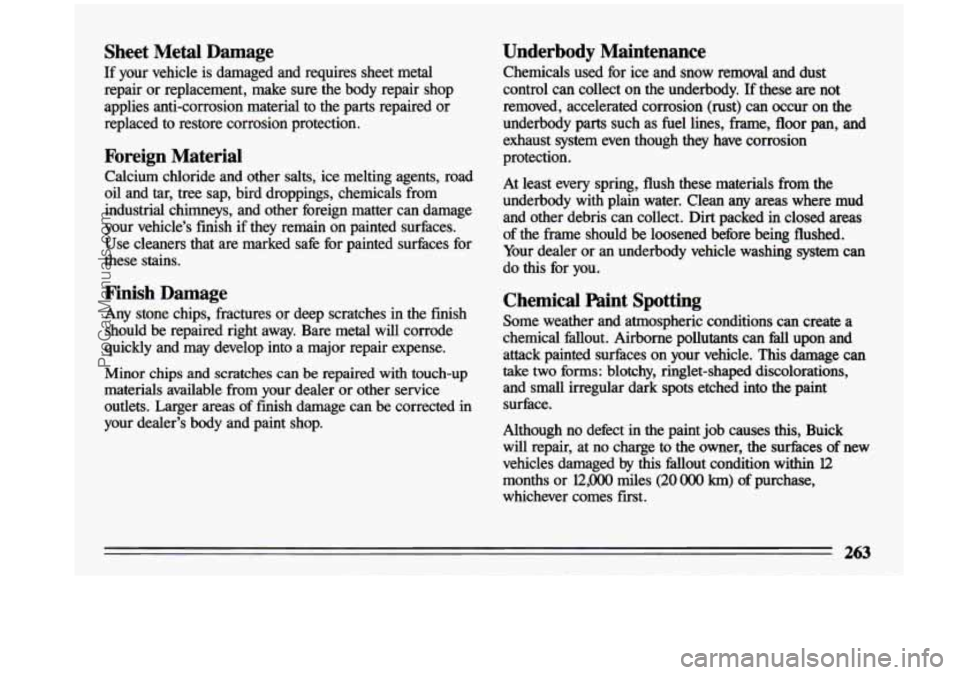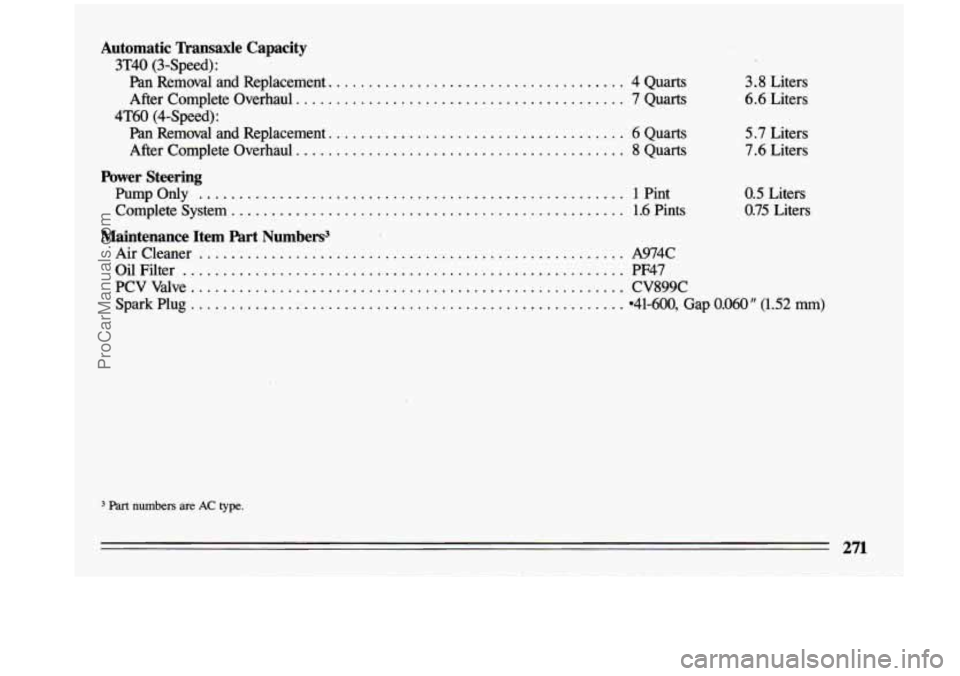1993 BUICK CENTURY maintenance
[x] Cancel search: maintenancePage 238 of 324

Automatic ‘mansaxle Fluid
When to Check and Change:
A good time to check your automatic transaxle fluid level
is when the engine oil is changed. Refer to the
Maintenance Schedule to determine when to change your
fluid. See “Scheduled Maintenance Services” in the
Index.
How to Check:
Because this operation can be a little difficult, you may
choose to have
this done at a Buick dealership Service
Department.
If you do it yourself, be sure to follow all the instructions
here, or you could get a false reading on the dipstick. Wait at least
30 minutes before checking the transaxle
fluid level
if you have been driving:
When outside temperatures are above 90°F (32°C).
At high speed for quite a while.
In heavy traffic-especially in hot weather.
While pulling a trailer.
To get the right reading, the fluid should be at normal
operating temperature, which is
180°F to 200” F (82” C to
93°C).
Get the vehicle warmed up by driving about 15 miles
(24 km) when outside temperatures are above 50°F
(10°C). If it’s colder than 50” F (lO°C), you may have to
drive longer.
To check the fluid level:
Park your vehicle on a level place.
0 Place the shift lever in “P” (Park) with the parking
brake applied.
With your foot on the brake pedal, move the. shift lever
through each gear range, pausing for about three
seconds in each range. Then, position the shift lever in
“P” (Park).
Let the engine run at idle for three to five minutes.
236
ProCarManuals.com
Page 240 of 324

A
A
A
. .. 1
A
3. Check both sides of the dipstick, and read the lower
level. The fluid level must be
in the cross-hatched
area.
4. If the fluid level is where it should be, push the
dipstick back in all the way.
How To Add Fluid:
Refer to the Maintenance Schedule to determine what
kind of transaxle fluid
to use. See “Recommended Fluids
and Lubricants” in the Index.
If the fluid level is low, add only enough of the proper
fluid to bring the level into the cross-hatched area on the
dipstick. It doesn’t
take much fluid, generally less than a
pint. Don’t overfill.
We recommend you use only fluid labeled
DEXROP-IIE, because fluids with that label are made
especially for your automatic transaxle. Damage caused
by fluid other than DEXRON@-IIE is not covered by your
new vehicle warranty.
After adding fluid, recheck the fluid
level as described
under “How to Check.”
When the correct fluid level is obtained, push the
dipstick back in all the way.
238
ProCarManuals.com
Page 243 of 324

Radiator Pressure Cap
ur radiator cap is a 15 psi (105 kPa)
When you replace your radiator pressure cap, an AC@
cap is recommended.
Thermostat
Engine coolant temperature is controlled by a thermostat
in the engine coolant system. The thermostat stops the
flow of coolant through the radiator until the coolant
reaches a preset temperature.
When you replace
your thermostat, an AC@ thermostat is
recommended.
Power Steering Fluid
mp ”-- How to Check Power
Steering Fluid:
I Unscrew the cap and wipe
the dipstick with a clean f rag. Replace the cap and
completely tighten it. Then
remove the cap again and
look at the fluid level on the
dipstick. .1,. ,,
When me engine compartment is hot, the level should
When the engine compartment is cool, the level should
be at the “H” (Hot) mark.
be at the “C” (Cold) mark.
What to Add:
Refer to the Maintenance Schedule to determine what
kind
of fluid to use. See “Recommended Fluids and
Lubricants” in the Index.
241
ProCarManuals.com
Page 255 of 324

Tire Inspection and Rotation
To make your tires last longer, have them inspected and
rotated at the mileages recommended
in the Maintenance
Schedule. See “Scheduled Maintenance Services”
in the
Index.
Use this rotation pattern.
After the tires have been rotated, adjust the front and rear
inflation pressure as shown on the Tire-Loading
Information label. Make certain that -all wheel
nuts are
properly tightend. See “Wheel
Nut Torque” in the
Index.
1
I A CAUTION:
Rust or dirt on a wheel, or on the parts to
which
It Is fastened, can make the’wheel nuts
become loose after a Qlme. The wheel could
come off and cause an accident. When you
change a wheel, remove any rust or dirt from
places where the wheel attaches to the
vehlcle.
In an emergency, you can use a cloth
or a paper towel to do this; but be sure to us8
a scraper or wire brush later, if you need to, to
get
all the rust or dirt off. (See “Changing a
Flat Tlre” in the Index.)
253
ProCarManuals.com
Page 264 of 324

Don’t wash your vehicle in the direct rays of the sun.
Don’t use strong soaps or chemical detergents. Use liquid
hand, dish or car washing (non-detergent) soaps. Don’t
use cleaning agents that contain acid or abrasives. All
cleaning agents should be flushed promptly and not
allowed to dry on the surface, or they could stain. Dry
the finish with a
soft, clean chamois or a 100% cotton
towel to avoid surfhce scratches and water spotting.
High pressure car washes may cause water to enter your
vehicle.
Finish Care
Occasional waxing or mild polishing of your Buick may
be necessary to remove residue from the paint finish. You
can get
GM approved cleaning products from your
dealer. (See “Appearance Care and Maintenance Materials” in the Index.)
Your Buick has a “basecoat/clearcoat” paint finish. The
clearcoat gives more depth and gloss to the colored
basecoat.
Aluminum Wheels (If SO Equipped)
Your aluminum wheels have a protective coating similar
to the painted surface of your car. Don’t use strong soaps,
chemicals, chrome polish, or other abrasive cleaners on
them because you could damage this coating. After
rinsing thoroughly, a wax may be applied.
White Sidewall Tires
Your Buick dealer has a GM White Sidewall Tire
Cleaner. You can use a stiff brush with it.
Weatherstrips
These are places where glass or metal meets rubber.
Silicone grease there will make them last longer, seal
better, and not squeak. Apply silicone grease with a
clean cloth at least every six months.
262
ProCarManuals.com
Page 265 of 324

Sheet Metal Damage
If your vehicle is damaged and requires sheet metal
repair or replacement, make sure the body repair shop
applies anti-corrosion material to the parts repaired or
replaced to restore corrosion protection.
Foreign Material
Calcium chloride and other salts, ice melting agents, road
oil and tar, tree sap, bird droppings, chemicals from
industrial chimneys, and other foreign matter can damage
your vehicle’s finish if they remain on painted surfaces. Use cleaners that are marked safe for painted surfaces for
these stains.
Finish Damage
Any stone chips, fractures or deep scratches in the finish
should be repaired right away. Bare metal will corrode
quickly and may develop into a major repair expense.
Minor chips and scratches
can be repaired with touch-up
materials available from your dealer or other service
outlets. Larger areas of finish damage can be corrected in
your dealer’s body and paint shop.
Underbody Maintenance
Chemicals used for ice and snow removal and dust
control can collect on the underbody. If these
are not
removed, accelerated corrosion (rust) can occur on the
underbody parts such as fuel lines, frame,
floor pan, and
exhaust system even though they have corrosion
protection.
At least every spring, flush these materials from the
underbody
with plain water. Clean any areas where mud
and other debris can collect. Dirt packed
in closed areas
of the frame should be loosened before being flushed.
Your dealer or an underbody vehicle washing system can
do this for you.
Chemical paint Spotting
Some weather and atmospheric conditions can create a
chemical fdlout. Airborne pollutants can
f$ll upon and
attack painted surfaces on your vehicle. This damage can
take
two forms: blotchy, ringlet-shaped discolorations,
and small irregular dark
spots etched into the paint
surhce.
Although no defect in the paint job causes
this, Buick
will repair, at no charge to the owner, the surfaces
of new
vehicles damaged by this fallout condition within 12
months or 12,OOO miles (20 OOO km) of purchase,
whichever comes first.
ProCarManuals.com
Page 266 of 324

Appearance Care and Maintenance Materials
You can get these from your Buick dealer .
DESCRIPTION USAGE PAFlT NUMBER
Magic Mirror Creme Wax ............. Exterior cleaner and polish ......... 12345343
Spray-A-Squeak
..................... Weatherstrips ..................... 1052277
Silicone Grease
..................... Stops squeaks ..................... 1052863
Tar and Road
Oil Remover ............ Also removes old waxes, polishes .... 1050172
Chrome Cleaner and Polish
........... Removes rust and corrosion .......... 1050173
White Sidewall Tire Cleaner
.......... Cleans white and black tires ......... 1050174
VinyULeather Cleaner
............... Spot and stain removal .............. 1050214
Fabric Cleaner
...................... Spot and stain removal .............. 1050244
Multi-Purpose Powdered Cleaner
........ Cleans vinyl and cloth, also. tires ...... 1050429
and
mats
latches
Glass Cleaner
....................... Also spot cleans vinyls ............. 1050427
Lubriplate
(Wh~te Grease) ............ For hood. trunk, door hinges and ..... 1052349
Preservatone
.................. .... Vinyl Top Dressing ................ 1051055
Washer Solvent
..................... Windshield-washing system .......... 1051515
Spot Lifter
........................ For cloth ........................ 105l398*
Wash-Wax (concentrate)
.............. Exterior Wash ..................... 1052870
SIZE
16 oz . (0.473L)
12 oz . (0.354L)
1
oz . (0.02Skg)
16 oz . (0.473L)
16
oz . (0.473L)
16
oz . (0.473L)
32
oz . (0.946L)
16
oz . (0.473L)
23
oz . (0.680L)
6 lb
. (2.72kg)
12 oz . (0.340kg)
16
oz . (0.473L)
8 oz . (0.237L)
32
oz . (0.946L)
16
oz . (0.473L)
* Not recommended .for pigskin suede leather .
See your General Motors dealers for these products .
See your Maintenance Schedule for other products .
264
I
ProCarManuals.com
Page 273 of 324

Automatic Tkansaxle Capacity
3T40 (3-Speed) :
Pan Removal and Replacement. ....................................
After Complete Overhaul. ........................................
Pan Removal and Replacement. ....................................
After Complete Overhaul. ........................................
4T60 (4-Speed):
Power Steering
PumpOnly .....................................................
Complete System. ................................................
Maintenance Item part Numbers3
Air Cleaner
Oil Filter
. .
PCV Valve .
Spark Plug .
.....................................................
.....................................................
.....................................................
.....................................................
4 Quarts
7 Quarts
6 Quarts
8 Quarts
1 Pint
1.6 Pints
3.8 Liters
6.6 Liters
5.7 Liters
7.6 Liters
0.5 Liters
0.75 Liters
M4C PF47
CV899C
041-600, Gap
0.060 It (1.52 m)
Part numbers are AC type.
271
ProCarManuals.com